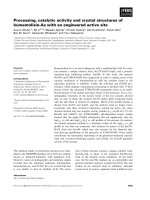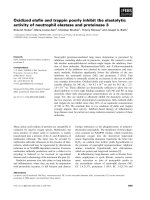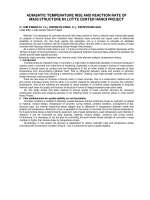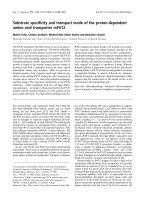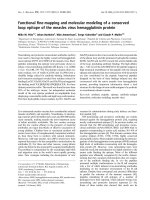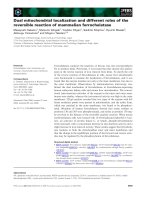Báo cáo khoa học: " Vegetative development, primary and secondary growth of the shoot system of young Terminalia superba tropical trees, in a natural environment. I. Spatial variation" pot
Bạn đang xem bản rút gọn của tài liệu. Xem và tải ngay bản đầy đủ của tài liệu tại đây (1.62 MB, 14 trang )
Original
article
Vegetative
development,
primary
and
secondary
growth
of
the
shoot
system
of
young
Terminalia
superba
tropical
trees,
in
a
natural
environment.
I.
Spatial
variation
in
structure
and
size
of
axes
E
de
Faÿ
Université
de
Nancy
I,
Laboratoire
de
biologie
des
Ligneux,
BP
239,
54506
Vandœuvre-lès-Nancy
Cedex,
France
(Received
21
August
1991;
accepted
17 April 1992)
Summary —
Spatial
variations
in
trunk
structure
including
wood
histology
and
size
of
axes
were
ex-
amined
in
5
21-month-old
Terminalia
superba
Engl
and
Diels
trees,
grown
in
a
natural
tropical
envi-
ronment.
Long
and
shorter
internode
series
alternated
along
the
main
axes,
forming
rather
poorly
delimited
units
of
extension.
In
trunk
wood,
the
paratracheal
axial
parenchyma
of
the
confluent
type
formed
irregular
bands,
the
spacing
of
which
varied
gradually,
increasing
and
decreasing
alternately.
These
widely-
and
narrowly-
spaced
parenchyma
bands
differentiated
various
wood
layers.
The
radi-
al
enlargement
and
wall
thickness
of
fibres
also
varied
in
the
same
manner,
as
did,
but
to
a
lesser
extent,
the
width
of
parenchymal
bands,
the
radial
enlargement
of
parenchyma
cells
and
vessels,
and
the
wall
thickness
of
vessels.
The
number
of
various
wood
layers
in
trunk
segments
that
were
defined
by
variations
in
intemodal length
was
not
related
to
the
order
of
appearance
of
the
trunk
seg-
ments
in
question.
These
results
suggest
that
trunk
wood
exhibited
alternating
dense and
not
very
dense
wood
layers,
but
they
did
not
provide
visible
structural
evidence
of
a
well-pronounced
growth
periodicity
in
the
main
shoot
of
Terminalia
superba.
The
existence
of
a
structural
discontinuity
in
the
peripheral
wood
and
the
significance
of
the
basipetal
differentiation
of
the
outermost
adjacent
wood
layer
have
been
discussed
in
relation
to
seasonal
changes
in
climate
and
phenology.
On
the
other
hand,
trunk
thickness
increased
markedly
from
5
cm
above
to
5
cm
beneath
the
upper
pseudo-
whorls
of
branches.
The
thickness
of
axes
(branches
and
trunks)
was
closely
related
to
the
number
of
sympodial
units
located
in
a
centrifugal
and
an
upper
position
respectively.
Moreover,
a
pseudo-
whorl
of
branches
was
generally
inserted
in
the
middle
part
of
trunk
segments
defined
by
variations
in
internodal
length.
These
data
indicate
trunk-branch
correlations.
It
is
suggested
that
some
struc-
tural
variations
in
trunk
wood
could
be
related
to
branching.
radial
size
/
structural
unit
/
Terminalia
superba
/
tropical
tree
/
wood
Résumé —
Développement
végétatif,
croissance
primaire
et
secondaire
du
système
cauli-
naire
de
jeunes
arbres
tropicaux
de
l’espèce
Terminalia
superba,
dans
un
environnement
na-
turel.
I.
Variation
dans
l’espace
de
la
structure
et
de
la
dimension
des
axes.
Les
variations
dans
l’espace
de
la
structure
du
tronc -
y
compris
l’histologie
du
bois -
et
de
la
dimension
des
axes
furent
examinées
chez
5
plants
de
Terminalia
superba
Engl
et
Diels
âgés
de
21
mois
et
poussant
dans
un
environnement
naturel
tropical.
Des
séries
d’entre-nœuds
longs
et
plus
courts
alternaient
le
long
des
axes
principaux
formant
des
unités
de
croissance
mal
délimitées.
Dans
le
bois
des
troncs,
le
paren-
chyme
axial
paratrachéal,
de
type
confluent,
formait
des
bandes
irrégulières
dont
l’espacement
variait
graduellement,
augmentant
et
diminuant
en
alternance.
Ces
bandes
de
parenchyme
largement
et
fai-
blement
espacées
différenciaient
des
couches
de
bois.
La
dilatation
radiale
et
l’épaisseur
des
parois
des
fibres
variaient
aussi
de
la
même
manière
que
précédemment.
Il
en
était
de
même,
quoique
à
un
moindre
degré,
de
l’épaisseur
des
bandes de
parenchyme,
de
la
dilatation
radiale
des
cellules
paren-
chymateuses
et
des
vaisseaux,
et
de
l’épaisseur
des
parois
des
vaisseaux.
Le
nombre
de
couches
de
bois
dans
les
segments
de
tronc
définis
par
des
variations
dans
la
longueur
des
entre-nœuds
n’était
pas
lié
à
l’ordre
d’apparition
des
segments
en
question.
Tous
ces
résultats
suggèrent
que
le
bois
des
troncs
présentait
des
couches
alternativement
denses
et
peu
denses,
mais
ils
ne
donnent
pas
de
preuve
structurale
d’une
périodicité
de
croissance
bien
marquée
dans
la
flèche
des
Terminalia
superba.
L’existence
d’une
discontinuité
structurale
dans
le
bois
périphérique
et
la
signification
de
la
couche
de
bois
adjacente
la
plus
externe
sont
discutées
en
relation
avec
les
changements
de
saison
et
de
phénologie.
Par
ailleurs,
l’épaisseur
des
troncs
s’accroissait
de
façon
marquée
de
5
cm
au-
dessus
à
5
cm
en-dessous
des
étages
supérieurs
de
branches.
L’épaisseur
des
axes
(branches
et
troncs)
était
étroitement
liée
au
nombre
d’unités
sympodiales
en
position
respectivement
centrifuge
et
supérieure.
De
plus,
un
étage
de
branches
était généralement
inséré
dans
la
partie
médiane
des
seg-
ments
de
tronc
définis
par
des
variations
dans
la
longueur
des
entre-nœuds.
Ces
données
attirent
l’attention
sur
les
corrélations
entre
branches
et
tronc.
II
est
suggéré
que
des
variations
structurales
dans
le
bois
du
tronc
pourraient
être
liées
à
la
ramification.
dimension
radiale / unité
structurale
/Terminalia
superba
/
arbre
tropical
/ bois
INTRODUCTION
Some
attention
has
been
paid
to
growth
phenomena
in
tropical
trees.
Morphological
and
morphogenetic
studies
on
shoot
growth
have
demonstrated
the
basic
knowledge
of
continuous
and
flushing -
or
rhythmic -
growth
and
architectural
models
(Bond,
1942; 1945;
Scarrone,
1965;
Hallé
and
Martin,
1968;
Borchert,
1969;
Hallé
and
Oldeman,
1970;
Greathouse
et
al,
1971;
Vogel,
1975a,b;
Hallé
et al,
1978;
Ng,
1979;
Parisot,
1988;
El-Morsy
and
Millet,
1989).
Concerning
secondary
growth,
there
is
some
information
on
wood
production
and
on
the
existence,
anatomy
and
periodicity
of
growth
rings
in
the
wood
of
numerous
species
(Hummel,
1946;
Mariaux,
1967;
Lowe,
1968;
Mariaux, 1969,
1970;
Gill,
1971;
Amobi,
1974;
Détienne
et
Mariaux,
1975, 1976,
1977;
Fahn
et al,
1981;
Mari-
aux,
1981;
Zamski,
1981;
Ash,
1983a,
b;
de
Faÿ,
1985;
Boninsegna
et
al,
1989;
Dé-
tienne,
1989;
Jacoby,
1989;
Worbes,
1989).
These
data
suggest
various
patterns
of
cambial
growth
among
the
trees
of
the
inter-
tropical
zone.
However,
detailed
studies
on
cambial
activity,
such
as
histophysiological
investigations
are
still
rare,
fragmentary
and
generally
concern
mature
trees
growing
in-
termittently,
the
wood
of
which
displays
an-
nual
growth
rings
(Lowe,
1968;
Paliwal
and
Prasad,
1970;
Lawton
and
Lawton,
1971;
Rao,
1972;
Amobi,
1973;
Paliwal
et
al,
1976;
Ghouse
and
Shamima
Hashmi,
1979;
Zamski,
1979;
Rao
and
Dave,
1981;
Rog-
ers,
1981;
Dave
and
Rao,
1982;
Desh-
pande
and
Rajendrababu,
1985;
Venugopal
and
Krishnamurthy,
1987).
As
regards
cor-
relations
between
growing
organs,
only
re-
lationships
between
leaf
and
shoot
growth
have
been
examined
in
a
few
tropical
trees
(Greathouse
et
al,
1971;
Prévost,
1972;
Borchert,
1973,
1978)
and
the
effect
of
leaves
on
internode
elongation
has
been
demonstrated
in
Terminalia
superba
(Mail-
lard
et al,
1987b).
Young
plants
of
the
African
species
Ter-
minalia
superba
Engl
and
Diels
grown
in
a
natural
environment
were
studied
within
the
context
of
research
on
growth
rhythms
and
relationships
between
primary
and
secondary
growths
of
the
shoot
system.
T
superba
is
a
forest
species,
the
architec-
ture
of
which
has
been
characterized
by
Hallé
and
Oldeman
(1970)
as
Aubréville’s
model.
Its
trunk
is
a
monopode,
the
growth
of
which
is
assumed
to
be
rhythmic
and
gives
branches
a
pseudowhorled
arrange-
ment,
commonly
called
a
tier.
Branches
are
sympodial
and
horizontal
by
apposition
to
spiral
phyllotaxy
units.
Each
sympodial
unit
is
characteristic
of
the
genus
Terminal-
ia,
the
Terminalia
branching
being
specifi-
cally
described
in
T
catappa
(Hallé
and
Oldeman,
1970;
Tomlinson
and
Gill,
1973;
Fisher,
1978).
The
vegetative
development
of
T superba,
at
an
early
stage,
has
recent-
ly
been
studied
under
controlled
conditions
(Maillard,
1987;
Maillard
et
al,
1987a,b;
1989).
These
authors
determined
the
most
favourable
conditions
for
growth
and
con-
sidered
growth
periodicity.
It
appears
that
the
trunk
displays
an
alternation
of
long
and
short
internode
series,
obvious
at
27 °C
and
under
14-
or
16-h
daylengths.
This
paper
reports
a
study
on
the
spatial
aspects
of
growth
in
a
natural
tropical
envi-
ronment.
The
purpose
was
not
only
to
com-
pare
the
vegetative
development
of
young
trees
under
natural
and
controlled
environ-
mental
conditions,
especially
the
formation
of
morphologically
discrete
growth
incre-
ments
(units
of
extension,
Hallé
et al,
1978),
but
also
to
increase the
number
of
criteria
which
would
allow
the
growth
of
Terminalia
superba
to
be
characterized.
Trunk
wood
structure
and
size
of
axes
were
thus
investi-
gated.
On
the
one
hand,
relationships
be-
tween
radial
size
of
axes
and
number
of
branch
modular
components,
ie
sympodial
units,
were
sought
in
addition
to
units
of
ex-
tension
along
trunks.
On
the
other
hand,
histological
investigations
on
trunk
wood
were
aimed
at
finding
structural
variations
in
relation
to
units
of
extension,
ie
rhythmic
growth
rings
(de
Faÿ,
1985).
MATERIALS
AND
METHODS
The
trees
studied
came
from
the
experimental
plantation
of
the
Centre
Technique
Forestier
Tropical
on
the
Ivory
Coast,
located
in
the
forest
of
Anguédédou,
about
30
km
north-west
of
Abid-
jan.
A
clonal
plot
was
put
at
the
author’s
dispo-
sal
to
study
5
trees.
The
trees
were
descended
from
stem
cuttings
that
had
been
made
from
3-
month-old
shoots
and
had
been
planted
3
months
later.
They
were
aged
21
months
when
studied.
A
good
size,
well-separated
tiers
of
branches
and
an
absence
of
any
trunk
reitera-
tion
were
the
criteria
for
the
choice
of
plants.
The
clonal
origin
was
unknown
at
the
time
of
se-
lection,
which
should
have
ensured
a
certain
variability
among
the
chosen
trees,
as
if
seed-
lings
had
been
studied.
The
5
trees
(TA-TE)
were
of
the
same
geographic
provenance,
2
were
half-sibs
(TA
and
TC)
and
2
were
of
the
same
clone
(TD
and
TE).
The
ground
had
been
prepared,
before
planting,
by
manual
cutting
of
the
forest
plot;
the
plant
spacing
was
initially
2.5
x
2.5
m;
manual
weeding
had
been
regular.
Therefore,
the
T superba
trees
were
not
growing
in
competition
for
light
with
other
vegetation.
They
had
been
subjected
to
full
sunlight.
As
the
species
T
superba
is
disseminated
throughout
the
evergreen
rain
forest
in
the
south
of
the
Ivory
Coast
and
it
invades
the
secondary
bush
(Aubréville,
1959),
the
variability
and
local
growing
conditions
of
the
trees
studied
were
ap-
parently
similar
to
those
of
’fraké’
saplings -
fra-
ké
is
the
local
common
name
of
this
species -
in
a
large
chablis
of
the
adjacent
forest.
The
site
is
located
in
the
intertropical
zone
at
about
5°
lati-
tude
north,
that
is
to
say
in
the
so-called
’humid
tropics’.
As
in
many
tropical
regions,
the
season-
al
variations
in
temperature
and
solar
radiation
are
not
great,
but the
amount
of
rainfall
is
distrib-
uted
irregularly.
There
are
2
dry
seasons
(De-
cember-March
and
mid
July-September)
alter-
nating
with
2
rainy
seasons
(April-mid
July
and
mid
September-November).
Thus
for
more
than
one
and
a
half
years,
the
young
trees
had
been
subjected
to
a
monthly
temperature
of
25-28
°C
(Atlas
de
la
Côte
d’Ivoire,
1978)
and
a
photoperi-
od
of
12.2-13.2
h
daylength,
allowing
for
dawn
and
dusk
(Longman
and
Jenik,
1963),
which
is
fairly
close
to
the
27
°C
and
14-h
daylength
found
to
be
the
most
favourable
for
the
develop-
ment
of
young
T
superba
trees
under
controlled
conditions
(Maillard
et al,
1987a).
However,
they
had
lived
through
several
dry
seasons
and
the
last
one
was
just
before
the
examination.
The
lack
of
rainfall
could
thus
have
restricted
plant
growth
seasonally.
For
observations
and
measurements,
trunks
were
cut
at
the
base,
at
the
beginning
of
March,
just
after
total
new
leafing
of
the
plants,
and
were
inspected
immediately
from
base
to
apex.
The
relative
position
of
leaf-scars,
or
leaves
in
the
upper
part
only,
was
studied
to
find
regions
with
short
internodes
or
an
alternation
of
long
and
shorter
internode
regions.
The
transition
zones
from
long
to
short
internode
regions
were
marked
to
delimit
units
of
extension.
When
the
limit
was
not
obvious,
the
middle
of
the
shortest
internode
was
taken
into
account
to
separate
successive
trunk
segments,
and
these
were
measured.
In
addition,
the
number
of
tiers
per
unit,
the
number
of
branches
per
tier,
the
num-
ber
of
sympodial
units
per
branch,
the
mean
ba-
sal
diameter
of
branches
and
the
circumference
of
trunks
at
5
cm
above
and
below
each
tier,
or
in
the
middle
of
a
unit
with
no
branch,
were
re-
corded.
For
histological
studies
of
the
wood,
2
kinds
of
sample
were
collected
in
the
middle
part
of
each
unit
of
extension,
beneath
the
tier
of
branches:
discs
and
cores.
Firstly,
the
2-3-cm
long
discs
were
put
into
an
air-conditioned
room
to
dry;
afterwards,
they
were
treated
with
sodi-
um
hypochlorite
to
lighten
them
(Mariaux,
1969)
and
finely
polished;
they
were
observed
with
a
stereomicroscope
before
and
after
treatment
with
phloroglucinol-HCl,
characterizing
lignins
(Sass,
1958).
Secondly,
the
outermost
trunk
tis-
sues,
including
wood,
were
sampled
with
a
bone
puncture
surgical
instrument
and
the
cores
were
fixed
in
Craf
1
(Sass,
1958);
they
were
then
cut
transversely
with
a
freezing
mi-
crotome,
and
the
40-μm
thick
sections
were
stained
with
phloroglucinol-HCl
and
examined
microscopically.
RESULTS
Spatial
variations
in
external
structure
and
size
of
axes
Typical
units
of
extension,
ie
trunk
seg-
ments,
well-delimited
by
areas
of
more
tightly
packed
leaf-scars,
could
not
be
ob-
served
along
the
trunks,
except
at
the
top;
indeed,
there
was
only
a
sharp
limit
at
the
base
of
the
developing
part,
in
4
out
of
5
trees.
However,
on
the
lower
part,
there
were
several
areas
with
some
relatively
short
internodes,
compared
with
the
adja-
cent
regions.
Variations
in
internodal
length
occurred
progressively.
It
should
be
noted
that
a
slight
variation
might
pass
un-
noticed
and,
moreover,
leaf-scars
tended
to
become
indistinct
on
the
old
parts
of
trunks.
Nevertheless,
trunk
segments
con-
sisting
of
long
internode
series
separated
by
shorter
internode
series
could
be
distin-
guished
(fig
1).
These
poorly
delimited
segments
gener-
ally
bore
one
tier
of
branches
located
in
the
central
part.
However,
2
sets
of
branches
were
observed
in
2
different
seg-
ments
and,
in
the
basal
segments,
some-
times
no
branch
was
found
(fig
1).
Concerning
axis
sizes,
the
circumfer-
ence
of
trunks
increased
from
apex
to
base
but
irregularly
on
each
side
of
the de-
veloping
tiers
of
branches.
In
addition,
the
basal
diameter
of
branches
was
correlated
positively
with
the
number
of
component
sympodial
units
(fig
2).
A
close
relationship
was
also
found
between
trunk
circumfer-
ence
and
the
total
number
of
sympodial
units
in
the
branches
inserted
above
the
level
studied
(fig
3).
Structural
variations
in
trunk
wood
The
wood
of
the
trunks
showed
slight
con-
centric
colour
variations
in
polished
trans-
verse
sections.
A
stereomicroscope
high-
lighted
numerous
light
irregular
concentric
bands
on
a
comparatively
dark
back-
ground
(figs
4A,
B).
These
bands
were
paratracheal
axial
parenchyma
of
the
con-
fluent
type.
In
general,
band
spacing
var-
ied
gradually,
increasing
and
decreasing
alternately.
The
dark
background
of
the
transverse
sections
of
wood
con-
sisted
of
wood
fibres.
Positive
phlorogluci-
nol-HCl
tests
showed
wood
fibres
ar-
ranged
in
alternating
concentric
layers
(fig
5A).
These
variations
resulted
mainly
from
changes
in
the
number
of
cells
per
unit
area
(fig
5B).
These
2
types
of
concentric
and
repeat-
ed
variations -
in
the
spacing
of
parenchy-
ma
bands
and
in
the
intensity
of
staining -
were
not
always
closely
correlated,
espe-
cially
in
the
lower
trunk
segments.
More-
over,
the
thickness
of
wood
layers
varied
strongly
within
a
trunk
section,
particularly
in
the
lower
segments:
a
single
wood
layer
was
sometimes
thick
and
sometimes
thin;
the
different
wood
layers
that
were
defined
by
the
same
feature
had
very
different
thicknesses,
in
the
internal
wood,
whatever
their
position;
the
thickness
of
adjacent
wood
layers
varied
independently:
for
in-
stance
the
wood
layers
with
relatively
nar-
row
band
spacing
were
sometimes
thick
and sometimes
thin
in
comparison
with
the
innermost
ones
with
wider
band
spacing.
The
great
structural
variability
in
trunk
wood
made
the
wood
layer
count
difficult.
Several
counts
of
the
wood
layers
that
were
defined
by
variations
in
band
spacing
were
made
in
each
trunk
sections
(on
the
2
polished
areas),
because
a
small
local
variation
of
band
spacing
could
at
first
pass
unnoticed.
The
results
(table
I)
showed
clearly
that
the
number
of
wood
layers
increased
basipetally
but
irregularly
from
one
trunk
segment
to
the
next
(older
one)
below.
The
most
recent
wood
layers
(2-5
ac-
cording
to
the
trunk
level)
were
distin-
guished
from
each
other
more
easily:
those
with
a
wide
spacing
of
parenchyma
bands
were
thick,
whereas
those
with
nar-
row
band
spacing
were
thin;
moreover,
parenchyma
bands
were
wider
in
the
for-
mer
than
in
the
latter
(figs
4A,
B).
The
staining
of
the
wood
background
following
phloroglucinol-HCl
test
was
less
in-
tense
in
the
wood
layers
with
wide
band
spacing
than
in
those
with
narrow
band
spacing.
Variations
in
staining
were
gradu-
al
from
one
wood
layer
to
another,
except
between
the
2
most
recent
wood
layers
(fig 6A).
Indeed,
the
limit
was
sharp
only
be-
tween
the
2
most
recent
wood
layers.
His-
tologically,
this
was
the
transition
between
strongly
radially
flattened,
thick-walled
fi-
bres
and
younger
radially
dilated,
thinner-
walled
fibres,
the
former
belonging
to
the
outermost
wood
layer
that
was
defined
by
narrowly-spaced
parenchyma
bands
and
the
latter
to
the
differentiating
wood
which
exhibited
widely-spaced
parenchyma
bands
(fig
6B).
This
boundary
was
not
always
uni-
form
at
the
cellular
level,
mainly
because
of
the
occurrence
of
parenchyma
bands.
In
this
area,
parenchyma
cells
changed
from
a
radially
flattened
type
to
a
radially
dilated
type -
more
precisely
from
a
rather
narrow
area
to
a
wider
area
in
cross
section
(fig
6B) -
and
vessels
from
small,
thick-walled
pores
to
large,
relatively
thin-walled
pores
(fig
6A).
The
microscopical
examination
did
not
indicate
noticeable
changes
in
wall
staining.
Histological
differences
between
wood
layers
with
narrow
and
wide
spac-
ings
of
parenchyma
bands
tended
to
be
less
visible
in
internal
wood
(figs
4A,
B,
5A,
B).
The
developing
wood
layer
was
found
in
the
5
trunks
studied,
but
its
thickness
decreased
basipetally
and
it
could
be
par-
tially
formed
or
totally
missing
in
the
base
of
the
trunk
(figs
4A,
B).
DISCUSSION
The
trunk
of
young
T
superba
trees
grown
in
a
natural
environment
was
characterized
by
alternating
series
of
long
and
shorter
in-
ternodes,
as
in
a
controlled
environment
chamber
(Maillard
et
al,
1987a),
which
generally
formed
poorly-delimited
units
of
extension.
The
vaguely
segmented
struc-
ture
of
the
trunk
was
confirmed
at
the
wood
level.
The
spacing
of
parenchyma
bands,
the
radial
enlargment
of
wood
fi-
bres
and
parenchyma
cells,
the
wall
thick-
ness
of
wood
fibres
and
to
a
lesser
extent
the
width
of
parenchyma
bands,
the
pore
size
and
wall
thickness
of
vessels
changed
in
such
a
way
that
wood
layers
were
sug-
gested
to
be
alternately
more
and
less
dense.
The
changes
were
generally
gradu-
al
and
apparently
bore
no
relation
to
the
development
of
the
units
of
extension.
Thus,
there
were
no
rhythmic
growth
rings
in
the
juvenile
wood
of
T
superba,
unlike
that
of
Hevea
brasiliensis
(de
Faÿ,
1985;
1986).
In
short,
structural
units
of
the
He-
vea
type,
characteristic
of
the
rhythmic
growth-habit
were
found
neither
externally
along
the
trunk
nor
in
trunk
wood.
Nevertheless,
the
structural
variations
in
wood
could
indicate
that
the
cambial
growth
of
trunks
was
alternately
rapid
and
slow,
especially
since
structural
variations
of
that
nature
are
visible
within
the
growth
rings
of
some
mature
tropical
trees
(Mari-
aux,
1967;
Boninsegna
et
al,
1989;
Dé-
tienne,
1989;
Vetter
and
Botosso,
1989;
Worbes,
1989).
In
fact,
the
abrupt
(spatial)
variations
of
trunk
thickness
were
related
to
the
upper
tiers
of
branches
and
there
was
a
close
relationship
between
trunk
thickness
and
size
of
branches
(in
number
of
modules)
that
were
inserted
above
the
level
studied.
Moreover,
trunk
segments
that
were
defined
by
variations
in
inter-
nodal
length
usually
bore
1
tier
of
branch-
es.
These
data
indicate
trunk-branch
cor-
relations
and
imply
that
some
structural
variations
in
trunk
wood
could
be
related
to
branching.
Indeed,
the
leaves
of
develop-
ing
axes
are
assumed
to
produce
the
stim-
uli
(phytohormones)
that
induce
the
differ-
entiation
of
wood
(Aloni,
1989).
Climatic
variations
could
also
have
had
repercussions
on
wood
formation,
espe-
cially
the
lack
of
rainfall,
as
in
the
wood
of
Carya
glabra
where
the
spacing
of
tangen-
tial
parenchyma
bands
is
related
to
the
rate
of
rainfall
(Hill,
1982).
At
any
rate,
the
outer
structural
discontinuity
in
the
trunk
wood
of
the
trees
studied
could
be
related
to
a
seasonal
change,
at
least
in
phenolo-
gy.
Indeed,
initiation
of
the
basipetally
de-
veloping
wood
layer
was
associated
in
time
with
the
bud
break
(this
had
begun
2
weeks
before
sampling
and
had
followed
the
totally
leafless
period
occurring
at
the
end
of
the
long dry
season).
Reduction
or
absence
of
the
developing
wood
layer
at
the
base
of
trunks
should
indicate
a
delay
in
the
resumption
of
cambial
activity,
be-
cause
of
the
basipetal
decrease
in
leaf
hor-
mone
stimulation
(Aloni,
1989).
The
peri-
pheral
structural
discontinuity
in
trunk
wood
should
be
the
sign
of
a
rest
during
the
totally
leafless
period
when
the
trees
were
almost
2
years
old.
It
should
be
point-
ed
out
that
some
younger
T superba
plants
growing
in
the
same
climate
showed
low
or
no
radial
increments,
or
trunk
shrinkage
in
February,
ie
at
the
end
of
the
long
dry
sea-
son
(de
Faÿ,
1992).
Wood
differentiation
in
the
trunks
of
young
T
superba
plants
could
thus
be
altered
by
drought
or
other
causes
of
internal
water
deficit.
In
conclusion,
the
trunk
of
young
T
su-
perba
tropical
trees
grown
in
a
natural
en-
vironment
did
not
have
the
typical
features
of
flushing
species,
such
as
Hevea
brasi-
liensis
(Hallé
and
Martin,
1968;
de
Faÿ,
1985),
Theobroma
cacao
(Greathouse
et
al,
1971;
Vogel,
1975a,
b;
de
Faÿ,
unpub-
lished
results)
or
Quercus
robur
(Payan,
1982;
Champagnat
et
al,
1986).
These
re-
sults
on
spatial
variations
in
structure
and
size
of
axes
indicate
trunk-branch
correla-
tions
rather
than
typical
units
of
extension
along
the
trunk
and
rhythmic
growth
rings
in
trunk
wood.
A
subsequent
study
of
temporal
aspects
of
growth
in
young
T
superba
trees
in
the
same
natural
environment
(de
Faÿ,
1992)
has
already
given
results
in
accor-
dance
with
the
present
data.
It
is
thus
sug-
gested
that
the
’pagoda’
architecture
of
Ter-
minalia
superba
resulted
more
from
the
periodicity
of
branching
than
from
a
flushing
growth
of
trunk,
at
least
in
the
early
stage.
ACKNOWLEDGMENTS
The
author
is
grateful
to
the
late
Director
of
the
Centre
Technique
Forestier
Tropical
on
the
Ivo-
ry
Coast,
Dr
K
Diabate
and
his
colleagues
for
providing
plant
material
and
Professor
JM
Favre
(University
of
Nancy
I)
for
his
critical
reading
of
the
manuscript.
REFERENCES
Aloni
R
(1989)
Control
of
xylogenesis
within
the
whole
tree.
Ann
Sci
For,
46
suppl
267s-272s
Amobi
CC
(1973)
Periodicity
of
wood
formation
in
some
trees
of
lowland
rainforest
in
Nigeria.
Ann
Bot 37, 211-218
Amobi
CC
(1974)
Periodicity
of
wood
formation
in
twigs
of
some
tropical
trees
in
Nigeria.
Ann
Bot 38, 931-936
Ash
J
(1983a)
Growth
rings
in
Agathis
robusta
and
Araucaria
cunninghamii
from
tropical
Australia.
Austr J Bot
31,
269-275
Ash
J
(1983b)
Tree
rings
in
tropical
Callitris
ma-
cleayana
F
Muell.
Aust
J
Bot
31,
277-281
Aubréville
A
(1959)
La
Flore
Forestière
de
la
Côte
d’Ivoire.
Centre
Tech
For
Trop,
Nogent
sur
Marne,
France,
vol
3
Bond
TET
(1942)
Studies
in
the
vegetative
growth
and
anatomy
of
the
tea
plant
(Camel-
lia
thea
Link)
with
special
reference
to
the
phloem.
I.
The
flush
shoot.
Ann
Bot
6,
607-
629
Bond
TET
(1945)
Studies
in
the
vegetative
growth
and
anatomy
of
the
tea
plant
(Camel-
lia
thea
Link)
with
special
reference
to
the
phloem.
II.
Further
analysis
of
the
flushing
behaviour.
Ann
Bot 9, 183-216
Boninsegna
JA,
Villalba
R,
Amarilla
L,
Ocampo
J
(1989)
Studies
on
tree
rings,
growth
rates
and
age-size
relationships
of
tropical
tree
species
in
Misiones,
Argentina.
IAWA
Bull
10, 161-169
Borchert
R
(1969)
Unusual
shoot
growth
pattern
in
a
tropical
tree
Oreopanax
(Araliaceae).
Am J Bot 56, 1033-1041
Borchert
R
(1973)
Simulation
of
rhythmic
tree
growth
under
constant
conditions.
Plant
Physiol 29, 173-180
Borchert
R
(1978)
Feedback
control
and
age
re-
lated
changes
of
shoot
growth
in
seasonal
and
nonseasonal
climates.
In:
Tropical
Trees
as
Living
Systems
(Tomlinson
PB,
Zimmer-
mann
MH,
eds)
Cambridge
Univ
Press,
497-
515
Champagnat
P,
Payan
E,
Champagnat
M,
Bar-
nola
P,
Lavarenne
S,
Bertholon
C
(1986)
La
croissance
rythmique
de
jeunes
chênes
pé-
donculés
cultivés
en
conditions
contrôlées
et
uniformes.
Coll
Int
sur
l’Arbre.
Nat
Monspe-
liensia,
303-337
Dave
YS,
Rao
KS
(1982)
Seasonal
activity
of
the
vascular
cambium
in
Gmelina
arborea
Roxb.
IAWA
Bull 3, 59-65
Deshpande
BP,
Rajendrababu
T
(1985)
Sea-
sonal
change
in
the
structure
of
the
secon-
dary
phloem
of
Grewia
tiliaefolia,
a
decidu-
ous
tree
from
India.
Ann
Bot 56,
61-71
Détienne
P
(1989)
Appearance
and
periodicity
of
growth
rings
in
some
tropical
woods.
IAWA
Bull
10,
123-132
Détienne
P,
Mariaux
A
(1975)
Nature
et
pério-
dicité
des
cernes
dans
le
bois
de
Niangon.
Bois
For
Trop
159,
29-37
Détienne
P,
Mariaux
A
(1976)
Nature
et
pério-
dicité
des
cernes
dans
le
bois
de
Samba.
Bois
For
Trop
169,
29-34
Détienne
P,
Mariaux
A
(1977)
Nature
et
pério-
dicité
des
cernes
dans
les
bois
rouges
de
Méliacées
africaines.
Bois
For
Trop
175,
52-
61
El-Morsy
AA,
Millet
B
(1989)
Analyse
de
la
crois-
sance
rythmique
du
mandarinier
commun
(Citrus
deliciosa
Tenore)
cultivé
en
condi-
tions
constantes.
Fruits 44,
21-27
Fahn
A,
Burley
J,
Longman
KA,
Mariaux
A,
Tomlinson
PB
(1981)
Possible
contributions
of
wood
anatomy
to
the
determination
of
age
of
tropical
trees.
In:
Age
and
Growth
Rate
of
Tropical
Trees:
New
Directions
for
Research
(Bormann
FH,
Berlyn
G,
eds)
Yale
Univ,
New
Haven, CT, 31-54
Faÿ
E
de
(1985)
Recherche
de
marqueurs
du
mode
de
croissance
cambiale
chez
Hevea
brasiliensis
(Euphorbiaceae) :
les
anneaux
de
croissance
rythmique
du
bois
juvénile.
Bull
Mus
Nat
Paris
4th
sér
7,
sect
B;
Adanso-
nia 2, 139-154
Faÿ
E
de
(1986)
Mode
de
croissance
cambiale
de
quelques
arbres
tropicaux
au
stade
juvé-
nile.
Coll
Int
sur
l’Arbre.
Nat
Monspeliensia
13-27
Fay
E
de
(1992)
Vegetative
development,
pri-
mary
and
secondary
growth
of
the
shoot
sys-
tem
of
young
Terminalia
superba
tropical
trees,
in
a
natural
environment.
II.
Terminal
growth,
lateral
growth
and
main
stem-branch
growth
correlations.
Ann
Sci
For 49,
403-422
Fisher
JB
(1978)
A
quantitative
study
of
Termi-
nalia
branching.
In:
Tropical
Trees
as
Living
Systems
(Tomlinson
PB,
Zimmermann
MH,
eds)
Cambridge
Univ
Press,
285-320
Ghouse
AKM,
Shamina
Hashmi
(1979)
Cambi-
um
periodicity
in
Polyalthia
longifolia.
Phyto-
morphology 29,
64-67
Gill
AM
(1971)
Endogenous
control of
growth
ring
development
in
Avicennia.
For
Sci
17,
462-465
Greathouse
DC,
Laetsch
WM,
Phinney
BO
(1971)
The
shoot-growth
rhythm
of
a
tropical
tree,
Theobroma
cacao.
Am
J
Bot
58,
281-
286
Hallé
F,
Martin
R
(1968)
Étude
de
la
croissance
rythmique
chez
l’Hévéa
(Hevea
brasiliensis
Müll-Arg
Euphorbiacées-Crotonoidées).
Adansonia
2
(8),
475-503
Hallé
F,
Oldeman
RAA
(1970)
Essai
sur
l’Architecture
et
la
Dynamique
de
Croissance
des
Arbres
Tropicaux:
Monogr
Bot
et
Biol
Vég.
Masson,
Paris
Hallé
F,
Oldeman
RAA,
Tomlinson
PB
(1978)
Tropical
Trees
and
Forests -
An
Architectural
Analysis.
Springer
Verlag,
Heidelberg
Hill
JF
(1982)
Spacing
of
parenchyma
bands
in
wood
of
Carya
glabra
(Mill)
sweet,
pignut
hickory,
as
an
indicator
of
growth
role
and
cli-
mate
factors.
Am
J
Bot 69,
529-537
Hummel
FC
(1946)
The
formation
of
growth
rings
in
Entandrophragma
macrophyllum
A
Chev
and
Khaya
grandifoliola
CDC.
Emp
For
Rev 25, 103-107
Jacoby
GC
(1989)
Overview
of
tree-ring
analysis
in
tropical
regions.
IAWA
Bull
10,
99-108
Lawton
JR,
Lawton
JRS
(1971)
Seasonal
varia-
tions
in
the
secondary
phloem
of
some
for-
est
trees
from
Nigeria.
New
Phytol
70,
187-
196
Longman
KA,
Jenik
J
(1963)
Tropical
Forest
and
Its
Environment.
Longmans,
New
York
Lowe
RG
(1968)
Periodicity
of
a
tropical
rain
for-
est
tree
Triplochiton
scleroxylon
K
Schum.
Commonw
For
Rev
47, 150-163
Maillard
P
(1987)
Étude
du
développement
vé-
gétatif
du
Terminalia
superba
Englers
et
Diels
en
conditions
contrôlées :
mise
en
évi-
dence
de
rythmes
de
croissance.
Thesis,
Univ
Paris
VI,
France
Maillard
P,
Jacques
M,
Miginiac
E,
Jacques
R
(1987a)
Croissance
de
jeunes
Terminalia
su-
perba
Englers
et
Diels
en
conditions
contrôlées.
Ann
Sci
For 44,
67-83
Maillard
P,
Jacques
M,
Miginiac
E
(1987b)
Cor-
relative
growth
in
young
Terminalia
superba
in
a
controlled
environment:
effect
of
the
leaves
on
internode
elongation.
Ann
Sci
For
60, 447-454
Maillard
P,
Jacques
M,
Miginiac
E,
Millet
B
(1989)
Mathematical
analysis
and
compari-
son
of
growth
fluctuations
of
the
aerial
system
of
young
Terminalia
superba
Englers et
Diels
(Combretaceae).
Ann
Sci
For 46 suppl;
Forest
Tree
Physiology
(Dreyer
E
et
al,
eds)
Elsevier,
INRA,
202s-
205s
Mariaux
A
(1967)
Les
cemes
dans
les
bois
tropi-
caux
africains,
nature
et
périodicité.
Bois
For
Trop
113,
3-14;
114, 23-37
Mariaux
A
(1969)
La
périodicité
des
cernes
dans
le
bois
de
Limba.
Bois
For
Trop
128,
39-54
Mariaux
A
(1970)
La
périodicité
des
cernes
dans
le
bois
de
l’Okoumé.
Bois
For
Trop
131,
37-50
Mariaux
A
(1981)
Past
efforts
in
measuring
age and
annual
growth
in
tropical
trees.
In: Age
and
Growth
Rate
of
Tropical
Trees:
New
Directions
for
Research
(Bormann
FH,
Berlyn
G,
eds)
Yale
University,
New
Haven,
CT
Ng
FSP
(1979)
Growth
rhythms
in
tropical
juve-
nile
trees.
Bull
Soc
Bot
Fr
126;
Actua
Bot
139-149
Paliwal
GS,
Prasad
NSRK
(1970)
Seasonal
activity
of
cambium
in
some
tropical
trees
I
Dalbergia
sissoo.
Phytomorphology
20,
333-
339
Paliwal
GS,
Saiwan
VS,
Shashi
Kanta
Aggarwal
(1976)
Seasonal
activity
of
cambium
in
some
tropical
trees
II
Salvadora
persica.
Act
Soc
Bot Polon
45, 303-311
Parisot
E
(1988)
Étude
de
la
croissance
ryth-
mique
chez
de
jeunes
manguiers
(Mangifera
indica
L).
Fruits 43,
97-312
Payan
E
(1982)
Contribution
à
l’étude
de
la
croissance
rythmique
chez
les
jeunes
chênes
pédonculés
(Quercus
pedonculata
Ehrh).
Thesis,
Univ
Clermont-Ferrand,
France
Prévost
MF
(1972)
Rythme
d’allongement
des
articles
de
Tabernaemontana
crassa
Benth
(Apocynacées).
Candollea
27, 219-227
Rao
AN
(1972)
Periodic
changes
in
the
cambial
activity
of
Hevea
brasiliensis.
J
Indian
Bot
Soc 51, 13-17
Rao
KS,
Dave
YS
(1981)
Seasonal
variations
in
the
cambial
anatomy
of
Tectona
grandis
(Verbenaceae).
Nord J Bot 1,
535-542
Rogers
S
(1981)
Seasonal
variation
in
radial
growth
and
phloem
activity
in
Terminalia
ivo-
rensis
A
Chev.
Ann
Bot 47,
603-610
Sass
JE
(1958)
Botanical
Microtechnique.
The
Iowa
State
University
Press,
Ames,
IA
Scarrone
F
(1965)
Rôle
respectif
des
rythmes
endogènes
et
des
facteurs
climatiques
dans
la
croissance
du
Manguier
(Mangifera
indica
L).
CR
Acad
Sci
Paris
260, 3469-3472
Tomlinson
PB,
Gill
AM
(1973)
Growth
habits
of
tropical
trees:
some
guiding
principles.
In:
Tropical
Ecosystems
in
Africa
and
South
America:
A
Comparative
Review
(Meggers
BJ,
Ayensu
ES,
Duckworth,
WD,
eds)
Smith-
sonian
Inst
Press,
Washington,
DC
Vennetier
P
(ed)
(1978)
Atlas
de
la
Côte
d’Ivoire.
Jeune
Afrique,
Paris
Venugopal
N,
Krishnamurthy
KV
(1987)
Seasonal
production
of
secondary
phloem
in
the
twigs
of
certain
tropical
timber
trees.
Ann
Bot 60, 61-67
Vetter
RE,
Botosso
PC
(1989)
Remarks
on
age
and
growth
rate
determination
of
Amazonian
trees.
IAWA
Bull 10, 133-146
Vogel
M
(1975a)
Croissance
rythmique
du
ca-
caoyer.
Thesis,
Univ
Paris
XI,
Orsay
Vogel
M
(1975b)
Recherche
du
déterminisme
du
rythme
de
croissance
du
cacaoyer.
Café
Cacao
Thé
19,
265-290
Worbes
M
(1989)
Growth
rings,
increment
and
age
of
trees
in
inundation
forests,
savannas
and
a
mountain
forest
in
the
Neotropics.
IAWA Bull 10,
109-122
Zamski
E
(1979)
The
mode
of
secondary
growth
and
the
three
dimensional
structure
of
the
phloem
in
Avicennia.
Bot
Gaz
140, 67-
76
Zamski
E
(1981)
Does
successive
cambial
diffe-
rentiation
in
Avicennia
depend
on
leaf
and
branch
initiation?
Israel J Bot 30,
57-64

